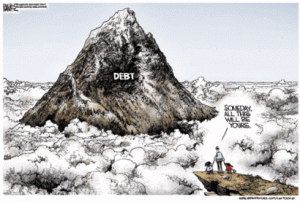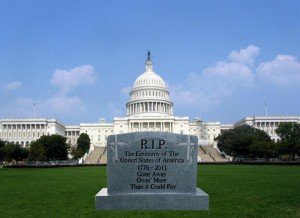The Destruction of The US Economy is Assured
Government strategy is misguided. It contradicts both common and economic sense. It will make the inevitable adjustment more painful. Instead of admitting their mistakes, government insists on compounding them.
From Monty Pelerin’s World
The slide toward sovereign bankruptcy and economic collapse continues. The best efforts of politicians and their sycophants in the media to convince you otherwise are being contradicted routinely by the the harsh facts of the marketplace. Their propaganda appears increasingly incredible.
best efforts of politicians and their sycophants in the media to convince you otherwise are being contradicted routinely by the the harsh facts of the marketplace. Their propaganda appears increasingly incredible.
The private economy has shown virtually no improvement despite stimuli in magnitudes never before imagined. After trillions of dollars of deficit spending and similar amounts of Fed monetary chicanery no recovery has occurred. No recovery can occur until massive amounts of debt are liquidated. Current debt levels are unsustainable for many. For others, the debt requires spending reductions in order to reduce it. Others will just have to default in one fashion or another.
 Much of the debt will never be repaid and will have to be defaulted upon. Government is trying to prevent this necessary liquidation from taking place. All that does is lock the economy into sub-standard performance, making a normal recovery impossible. In the process, government is adding massive new amounts of debt to their own over-leveraged situation.
Much of the debt will never be repaid and will have to be defaulted upon. Government is trying to prevent this necessary liquidation from taking place. All that does is lock the economy into sub-standard performance, making a normal recovery impossible. In the process, government is adding massive new amounts of debt to their own over-leveraged situation.
Government strategy is misguided. It contradicts both common and economic sense. It will make the inevitable adjustment more painful. Instead of admitting their mistakes, government insists on compounding them. What we are seeing is good politics in the short-run and terrible economics, both short and long-term. The political class will not take responsibility for this economic tragedy. Instead, they pretend that they are improving matters. Despite all the propaganda suggesting a recovery, cracks in the system are widening and about to burst. There is no way to avoid what is coming:
“There is no means of avoiding the final collapse of a boom
brought about by credit (debt) expansion. The alternative is only whether the crisis should come sooner as the result of a voluntary abandonment of further credit (debt) expansion, or later as a final and total catastrophe of the currency system involved.” Ludwig von Mises
Without political interference, debt defaults would trigger a Depression. However, politicians are unable and unwilling to stop spending money. Their desperate hope is that a managed inflation can be achieved and that a “soft” default ( i.e., a devaluation of the dollar that effectively reduces the real debt). If so, then borrowers will be able to “default” on their obligations by paying them down in much cheaper dollars.
The Debt Problem
The debt problem involves consumers, homeowners, commercial real estate and governments. The condition of the country and what is happening is aptly described by James Quinn:
“You have to admire the resourcefulness of the vested interests in disguising disaster and pretending that time will alleviate the consequences of their insatiable greed, blatant criminality and foolish risk taking. Extending bad loans and pretending they will be repaid does not create the cash flow necessary to actually pay the interest and principal on the debt.”
Consumer Debt
Consumer debt has decreased, primarily as a result of consumer defaults. James Quinn summarizes the consumer debt path with his quote and chart:
“Credit card debt grew from $265 billion in 1992 to a peak of $972
billion in September of 2008, when the financial system collapsed. The 267% increase in debt allowed Americans to live far above their means and enriched the Wall Street banking cabal. The decline to the current level of $800 billion was exclusively due to write-offs by the banks, fully funded by the American taxpayer.”
Residential Real Estate
Addison Wiggin provides the following estimates regarding potential residential real estate defaults:
“As of last September, there were about 800,000 “real estate owned” or REO homes in the United States – homes repossessed and on the market. Close to one-third of these – 250,000 – sit on the books of Fannie Mae, Freddie Mac and the Federal Housing Administration. That is, 250,000 homes are owned by you and me, the US taxpayers.
But that number is about to explode: According to Ken Harney at the real estate industry publication Inman News, “The three agencies face a tsunami-sized shadow inventory that is now heading their way – a combined 1.4 million delinquent loans on their books, at least half of which, they estimate, will end up in foreclosure.”
So now we’re talking that 250,000 number suddenly ballooning to nearly a million. The early-warning waves of the tsunami started lapping at the shore in November, when foreclosure auctions reached a nine-month high. The final numbers might end up even higher: Late-stage delinquencies tallied by Lender Processing Services in January approach 2 million.”
It should be noted that Mr. Wiggin sees these problems being addressed in a manner that represents another massive wealth transfer from citizens to the elite.
Commercial Real Estate Debt
James Quinn provides a complete and lengthy analysis of commercial real estate and debunks the notion that commercial real estate is doing well. There are massive write-offs that are unavoidable in the commercial sector and these are indicative of the weakened consumer and resulting retail bankruptcies. Here is Mr. Quinn’s summary:
“Do the results of these retail giants jive with the retail recovery stories being spun by the corporate mainstream media? When you see some stock shill on CNBC touting one of these retailers, realize he is blowing smoke up your ass. These six struggling retailers account for over 1.1 billion square feet of retail space in the U.S. One or more of them anchor every mall in America. Wal-Mart (600 million square feet in the U.S.) and Kohl’s (82 million square feet) continue to struggle as their lower middle class customers can barely make ends meet. The perfect storm is developing and very few people see it coming. Extend and pretend has failed. Americans are tapped out. Home prices continue to fall. Energy and food prices continue to rise. Wages are stagnant. Job growth is weak. Middle and lower class Americans are using credit cards just to pay their basic living expenses. The 99% are not about to go on a spending binge.
As consumers reduce consumption, retailers lose profits and will be forced to close stores. It is likely that at least 150,000 retail stores will need to close in the next five years. Less stores means less rent for mall developers. Less rent means the inability to service their debt as the value of their property declines with the outcome of Ghost Malls haunting your community. Maybe good old American ingenuity will come to the rescue as we convert ghost malls into FEMA prison camps for uncharged Ron Paul supporters, Obamacare death panel implementation centers, TSA groping educational facilities, housing for the millions kicked out of their homes by the Wall Street .01%ers, and bomb shelters for the imminent Iranian invasion.
Debt default means huge losses for the Wall Street criminal banks. Of course the banksters will just demand another taxpayer bailout from the puppet politicians. This repeat scenario gives new meaning to the term shop until you drop. Extending and pretending can work for awhile as accounting obfuscation, rolling over bad debts, and praying for a revival of the glory days can put off the day of reckoning for a couple years. Ultimately it comes down to cash flow, whether you’re a household, retailer, developer, bank or government. America is running on empty and extending and pretending is coming to an end.”
Government Debt
Federal government debt will be equal to 100% of GDP by the end of this year. Depending upon whose estimates you use for the promises associated with Social Security and Medicare, adding these liabilities into the funded debt raises the liabilities of the government to between 600 and 800%. Then there is the matter of ObamaCare which is not reflected anywhere at the moment. There is absolutely no way that this debt and these promises will be honored in their present forms. It is mathematically impossible!
It is not as if this problem is a secret. Warnings on this website have been issued since its inception. Others have pointed out the problem and how it would compound to unmanageable proportions for two decades or more. The following comment, reported from the G20 meeting, provides all you need to know about our precarious position:
“You look at the US budget deficit, and you cannot help but feel that this is a serious accident waiting to happen. And not just a serious US accident, but a serious global accident,” IIF chief Charles Dallara told a conference on the sidelines of a G20 meeting of finance ministers and central bankers.
In my opinion, most of the political class recognizes the impossibility of solving the debt problem. It is too far gone for them to deal with. They have committed to a strategy of keeping the dead economy alive for as long as possible. The patient is clinically dead and should be removed from the respirator. Instead, the political class will pretend and extend for as long as they can get away with it. They will continue to benefit while the rest of the country is plundered even more.
The unavoidable Depression will occur regardless of their actions. The only issue is whether it is triggered by a massive inflation or a debt collapse. An immediate debt collapse would be less painful for the citizens than hyperinflation. In a debt collapse, balance sheets are cleansed and the economy is purged of much of the mal-investment and mis-allocation that has built up over the last couple of decades. The liability side of balance sheets shrinks to the underlying value of the assets.
In a hyperinflation, savings and fixed incomes are destroyed. That is, much of the assets of prudent individuals is destroyed. We would enter the Depression later, but most of us would do so without any nest egg which would have been demolished by inflation. Further, the mal-investments and mis-allocations go on longer, making the pain and recovery from the Depression that occurs that much harder.
Help Make A Difference By Sharing These Articles On Facebook, Twitter And Elsewhere:
